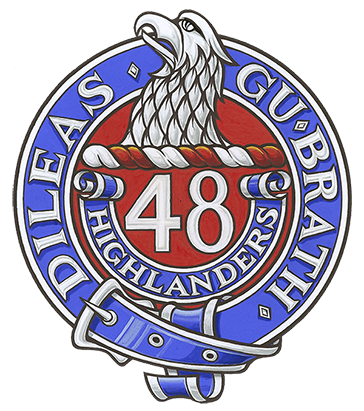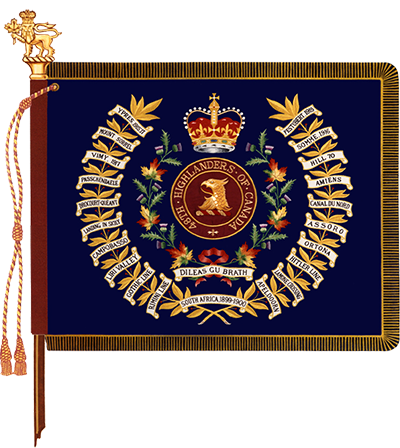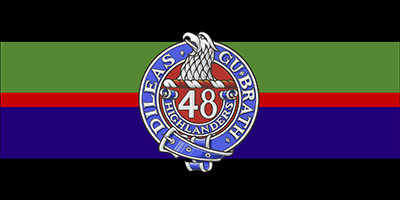48th Highlanders of Canada
The official lineage of the 48th Highlanders of Canada infantry regiment.

Colonel-in-Chief: Vacant
Badge
Description
On a torteau the number 48 Argent above a scroll Azure edged and inscribed HIGHLANDERS in letters Argent, all encircled by a belt Azure edged buckled and inscribed DILEAS GU BRATH in letters Argent, overall in chief on a wreath Argent and Gules a falcon's head couped Argent.
Symbolism
The falcon's head is adopted from the crest of the Clan Davidson, the regiment's first commanding officer being Lieutenant-Colonel John Irvine Davidson, and the predominant colours of red and blue are from the Davidson tartan that the regiment wears. The number "48" and the word "HIGHLANDERS" are a form of the regimental title and "DILEAS GU BRATH" is the motto of the regiment.
Motto
DILEAS GU BRATH (Faithful forever)
March
“The Highland Laddie”
Alliance
British Army
The Royal Regiment of Scotland
Regimental colour

Camp flag

Battle honours
South African War
SOUTH AFRICA, 1899-1900.
The First World War
YPRES, 1915, '17; Gravenstafel; St. Julien; FESTUBERT, 1915; MOUNT SORREL; SOMME, 1916; Pozières; Thiepval; Ancre Heights; ARRAS, 1917, '18; Vimy, 1917; Arleux; Scarpe 1917, '18; HILL 70; Passchendaele; AMIENS; Drocourt-Quéant; HINDENBURG LINE; Canal du Nord; PURSUIT TO MONS; FRANCE AND FLANDERS, 1915-18.
The Second World War
LANDING IN SICILY; Valguarnera; Assoro; Agira; ADRANO; Regalbuto; SICILY, 1943; Landing at Reggio; Campobasso; Torella; San Leonardo; The Gully; Ortona; San Nicola-San Tommaso; CASSINO II; Gustav Line; LIRI VALLEY; Hitler Line; GOTHIC LINE; LAMONE CROSSING; Misano Ridge; RIMINI LINE; San Martino-San Lorenzo; Fosso Vecchio; ITALY, 1943-1945; Apeldoorn; NORTH-WEST EUROPE, 1945.
South-West Asia
AFGHANISTAN
Lineage
This Reserve Force regiment originated in Toronto, Ontario on 16 October 1891, when the '48th Battalion "Highlanders"' was authorized to be formed.Footnote 1 It was redesignated: '48th Regiment "Highlanders"' on 8 May 1900;Footnote 2 'The 48th Regiment (Highlanders)' on 15 May 1920;Footnote 3 '48th Highlanders of Canada' on 1 August 1930;Footnote 4 '2nd (Reserve) Battalion, 48th Highlanders of Canada' on 7 November 1940;Footnote 5 and '48th Highlanders of Canada' on 31 December 1945.Footnote 6
Notes:
Upon redesignation as The 48th Regiment (Highlanders) on 15 May 1920 (see above), it was organized as a three battalion regiment with the 1st Battalion (15th Battalion, CEF) on the Non Permanent Active Militia order of battle, and the 2nd Battalion (92nd Battalion, CEF) and 3rd Battalion (134th Battalion, CEF) on the Reserve order of battle (GO 76/20). The reserve units were disbanded on 14 December 1936 (GO 3/37).
The 48th Regiment (Highlanders) were disbanded for the purpose of reorganization on 1 March 1921 and reorganized the same day (GO 133/21). This change was administrative and does not affect the lineage of the regiment.
On 4 May 1951, the regiment mobilized two temporary Active Force companies designated "E" and "F" Company (CAO 110-2, Pt 'B', Supp Issue No. 245/51; and SD 1 Letter No. 4237, 5 May 1951). "E" Company was reduced to nil strength upon its personnel being incorporated into the '1st Canadian Highland Battalion' for service in Germany with the North Atlantic Treaty Organization (SD 1 Letter No. 4365, 12 November 1951). It was disbanded on 29 July 1953 (CAO 78-2, Pt 'B', Supp Issue No. 352/53). "F" Company was initially used as a reinforcement pool for "E" Company. On 15 May 1952, it was reduced to nil strength, upon its personnel being absorbed by the newly formed '2nd Canadian Highland Battalion' for service in Korea with the United Nations (SD 1 Letter No. 4452, 22 April 1952; and CAO 110-2, Pt 'B', Supp Issue No. 283/52). "F" Company was disbanded on 29 July 1953 (CAO 78-2, Pt 'B', Supp Issue No. 352/53).
Perpetuations
15th', '92nd' and '134th "Overseas" Battalion(s), CEF'
Headquarters Location
Toronto, Ontario
Operational history
South African War
The regiment contributed volunteers for the Canadian Contingents, mainly the '2nd (Special Service) Battalion, Royal Canadian Regiment of Infantry'.Footnote 7
The First World War
The 15th Battalion, which was authorized on 1 September 1914 as the '15th Battalion, CEF',Footnote 8 embarked for Britain on 26 September 1914.Footnote 9 It disembarked in France on 15 February 1915,Footnote 10 where it fought as part of the 3rd Infantry Brigade, 1st Canadian Division in France and Flanders until the end of the war.Footnote 11 The battalion was disbanded on 30 August 1920.Footnote 12
The 92nd Battalion, which was authorized on 30 July 1915 as the '92nd "Overseas" Battalion, CEF',Footnote 13 embarked for Britain on 20 May 1916.Footnote 14 The battalion provided reinforcements to the Canadian Corps in the field until 24 January 1917, when its personnel were absorbed by the '5th Reserve Battalion, CEF'.Footnote 15 The battalion was disbanded on 1 September 1917.Footnote 16
The 134th Battalion, which was authorized on 22 December 1915 as the '134th "Overseas" Battalion, CEF',Footnote 17 embarked for Britain on 8 August 1916.Footnote 18 The battalion provided reinforcements to the Canadian Corps in the field until 7 March 1918, when its personnel were absorbed by the '12th Reserve Battalion, CEF'.Footnote 19 The battalion was disbanded on 29 November 1918.Footnote 20
The Second World War
The regiment mobilized the '48th Highlanders of Canada, CASF' for active service on 1 September 1939.Footnote 21 It was redesignated the '1st Battalion, 48th Highlanders of Canada, CASF' on 7 November 1940.Footnote 22 It embarked for Britain on 16 December 1939, and on 13 June 1940 it went to France as part of the Second British Expeditionary Force, reaching Sablé-sur-Sarthe before being ordered back.Footnote 23 It landed in Sicily on 10 July 1943 and in Italy on 3 September 1943 as part of the 1st Infantry Brigade, 1st Canadian Infantry Division.Footnote 24 In March 1945, the regiment moved with the 1st Canadian Corps to North West Europe, where it fought until the end of the war.Footnote 25 The overseas battalion was disbanded on 31 December 1945.Footnote 26
On 1 June 1945, a second Active Force component of the regiment was mobilized for service in the Pacific theatre of operations, under the designation '3rd Canadian Infantry Battalion (48th Highlanders of Canada), CASF'.Footnote 27 The battalion was disbanded on 1 November 1945.Footnote 28
South-West Asia
From 2002 to 2014, the 48th Highlanders of Canada reinforced various CAF units deployed to Afghanistan.Footnote 29